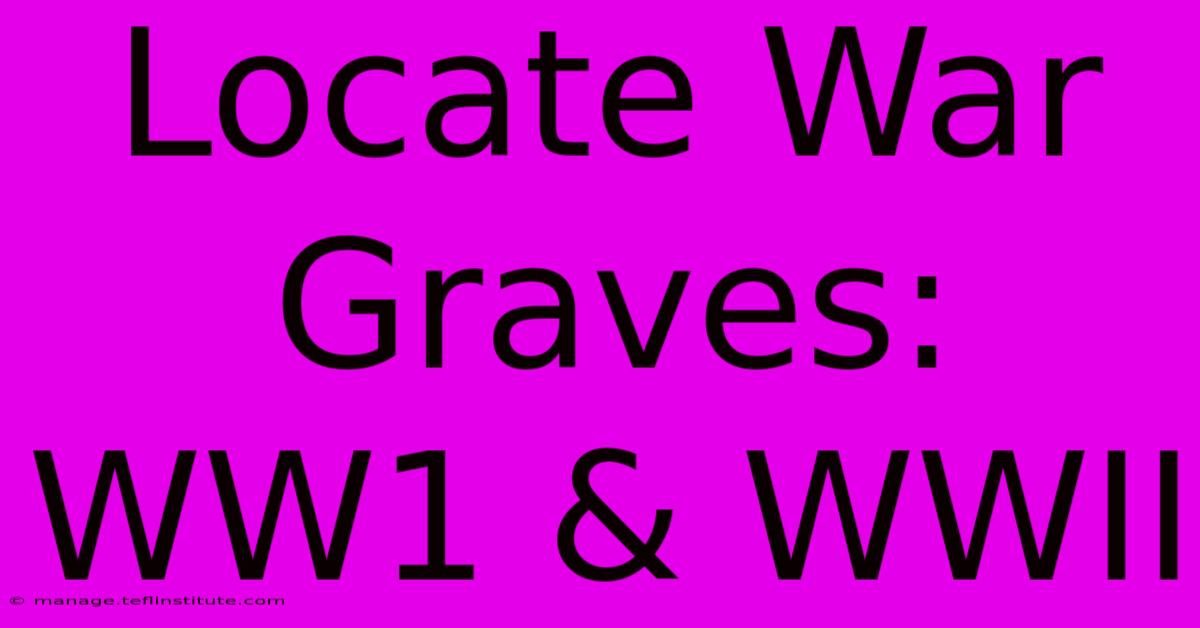Locate War Graves: WW1 & WWII

Table of Contents
Locating War Graves: Finding Peace in Remembrance
The scars of war may fade over time, but the memories of those lost in battle remain etched in the hearts of their loved ones. For families seeking closure, finding the final resting place of their ancestors who served in World War I and World War II can be a deeply personal and emotional journey. Fortunately, several resources exist to help locate war graves and honor their memory.
The Importance of Locating War Graves:
Beyond the sentimental value, finding a war grave can provide:
- Closure and peace: Identifying the resting place of a loved one can bring solace and closure to families.
- Historical connection: It allows individuals to connect with the sacrifices made by their ancestors and understand the historical context of their service.
- Honoring their memory: Visiting the grave and leaving a tribute allows individuals to pay their respects and ensure that their loved one's memory is not forgotten.
Resources for Locating War Graves:
1. Commonwealth War Graves Commission (CWGC):
- The CWGC maintains the graves of over 1.7 million Commonwealth soldiers who died in the two World Wars.
- Website: www.cwgc.org
- Search function: Their website offers a comprehensive search tool that allows users to locate graves by name, unit, or location.
- Cemetery information: The CWGC provides details on the cemeteries, memorials, and records for each grave.
2. American Battle Monuments Commission (ABMC):
- The ABMC oversees the American war cemeteries and memorials in Europe and North Africa.
- Website: www.abmc.gov
- Search function: Their website offers a search tool for finding the graves of American service members.
- Cemetery maps and information: The ABMC provides detailed maps and information on each cemetery.
3. National Archives and Records Administration (NARA):
- NARA houses a vast collection of military records, including service records, casualty lists, and burial records.
- Website: www.archives.gov
- Requesting records: Individuals can request records online or by mail, though accessing these records may require specific information.
4. Other Resources:
- Local historical societies: Local historical societies may possess records or information about local war cemeteries.
- Genealogy websites: Websites like Ancestry.com or FamilySearch.org can provide valuable information on family history and military service.
Tips for Locating War Graves:
- Gather as much information as possible: Before starting your search, collect any available details on the individual, such as their full name, unit, date of death, and location of service.
- Be patient and persistent: Finding war graves can be challenging, so be patient and persistent in your search.
- Contact the appropriate organizations: Contact the CWGC, ABMC, or NARA for assistance.
- Consider hiring a professional genealogist: If you're struggling to locate a grave, consider hiring a professional genealogist who specializes in military research.
Conclusion:
Locating the war graves of loved ones who fought in World Wars I and II is a meaningful way to honor their sacrifices and maintain their memory. With the resources available, families can embark on this journey of remembrance, finding closure and peace in the process.

Thank you for visiting our website wich cover about Locate War Graves: WW1 & WWII. We hope the information provided has been useful to you. Feel free to contact us if you have any questions or need further assistance. See you next time and dont miss to bookmark.
Featured Posts
-
Remembrance Day Find War Graves Online
Nov 10, 2024
-
Can Samardzic Help Atalanta Win It All
Nov 10, 2024
-
Uk Honors Wwii Kenyan Veterans Photos
Nov 10, 2024
-
Wrexham Captain Boycotts Anthem Stand
Nov 10, 2024
Latest Posts
-
Clashes Erupt During France Vs Israel Nations League Match
Nov 15, 2024
-
Nations League England Vs Greece Live Score
Nov 15, 2024
-
Nations League Fans Clash In France Israel Game
Nov 15, 2024
-
England Crushes Canada 9 2 In Cp Match
Nov 15, 2024
-
England Wins Big Over Canada In Cp Game
Nov 15, 2024
-
France Israel Match Marred By Fan Clashes
Nov 15, 2024
